Roman Forum Guide: Must-See Monuments
The Roman Forum, or Forum Romanum, is one of Rome’s most famous archaeological sites.
Located between the Palatine and Capitoline Hills, the Roman Forum was once the bustling center of Roman public life and served as the focal point for political, religious, and social activities in ancient Rome.
The Roman Forum was high on my list before coming to Rome, and I can assure you that it lives up to the expectations!
In this guide, I will walk you through the best monuments to see in the Roman Forum.
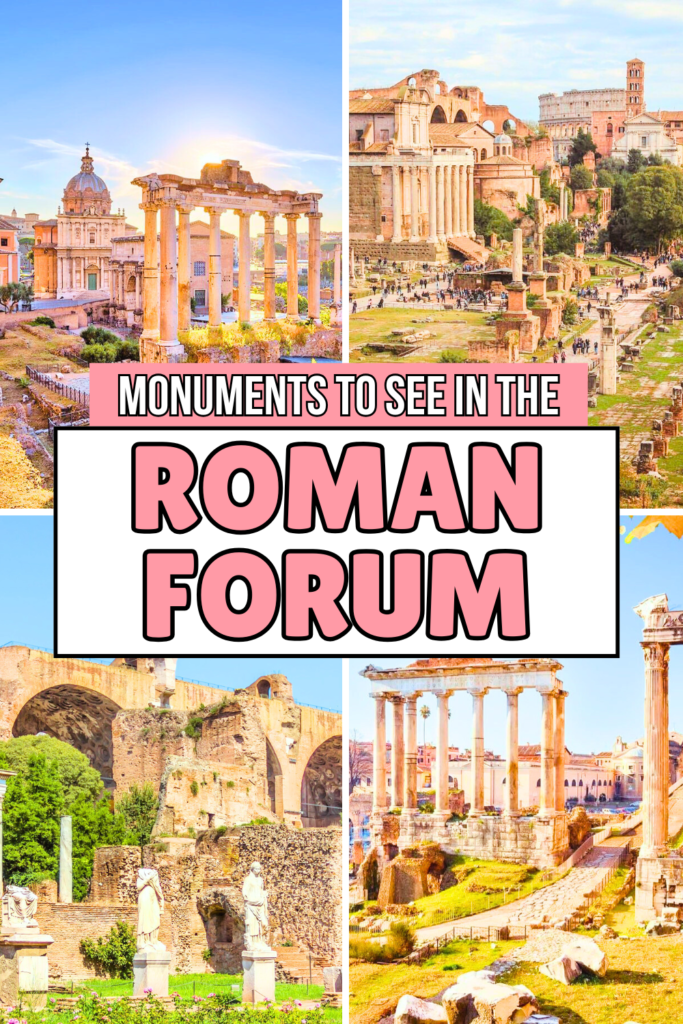
Disclosure: This post does contain affiliate links which I earn a small commission for at no extra cost to you. Any purchases you make through my links help keep the site running. Thanks in advance for your support!
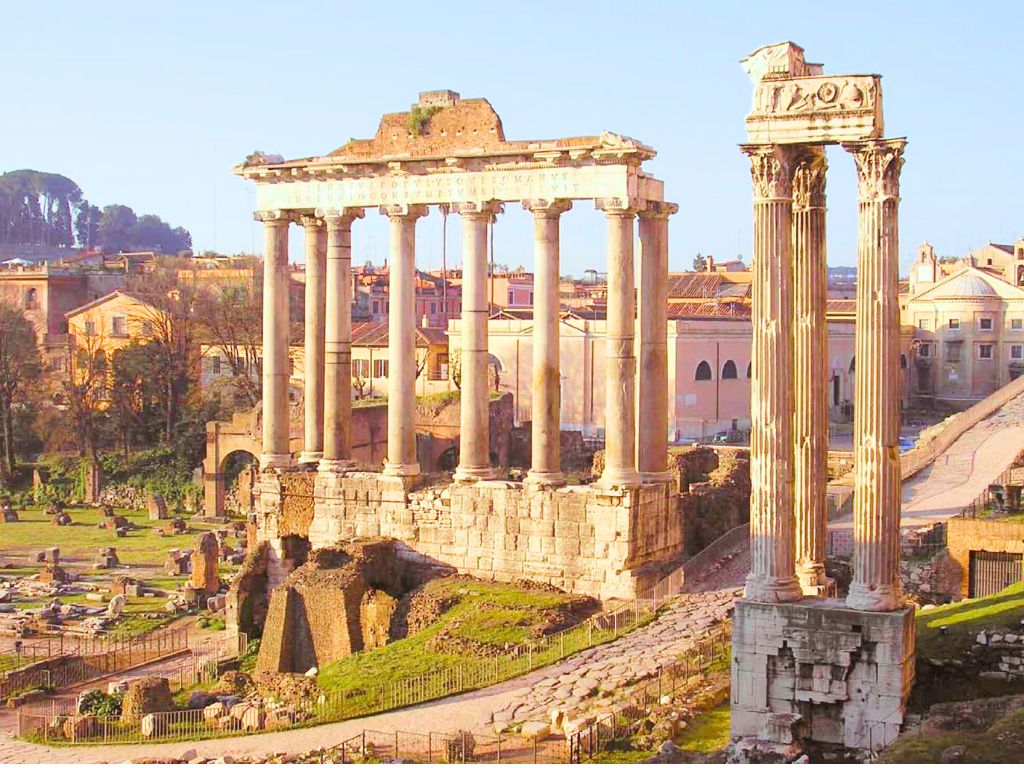
1. Temple of Saturn
The Temple of Saturn is one of the oldest temples in the Forum. It dates back to 497 BC and was originally dedicated to Saturn, the god of agriculture and wealth.
The towering eight columns that remain are just a fraction of what was once a grand structure, but they give you a sense of the temple’s scale and importance in its heyday.
In ancient times, the temple also served as a treasury for the Roman Republic, where the state’s wealth, including gold and silver, was stored.
The temple also played a big role during the Saturnalia festival, an annual celebration honoring Saturn that involved feasts, games, and even reversing social roles for the day.
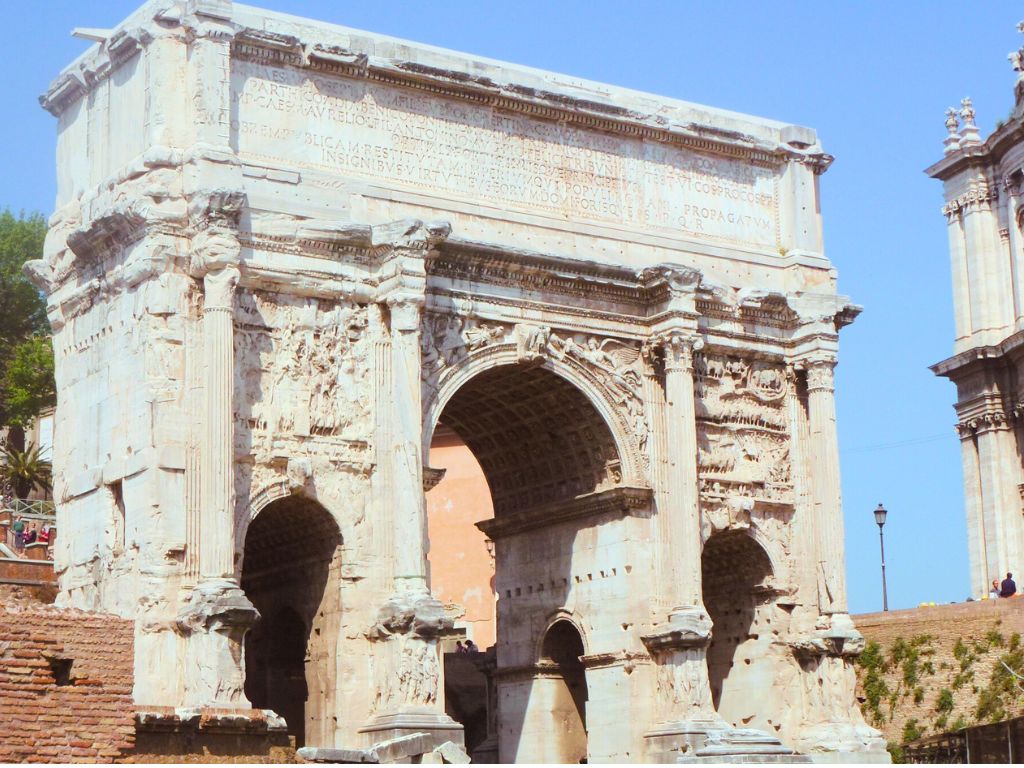
2. Arch of Titus
The Arch of Titus is a beautifully preserved piece of Roman engineering and a fascinating historical artifact all in one.
Built in 81 AD, this triumphal arch was created to celebrate Emperor Titus’s victory in the Siege of Jerusalem.
It’s one of the oldest surviving arches of its kind and served as a prototype for countless other triumphal arches around the world, including the famous Arc de Triomphe in Paris.
As you walk beneath it, you can’t help but feel the weight of history that this arch represents.
One of the coolest details of the Arch of Titus is the intricate carvings that tell the story of Titus’s victory.
Look closely, and you’ll spot soldiers carrying treasures from the Jewish Temple in Jerusalem, like the iconic Menorah.
These reliefs aren’t just art, they’re storytelling at its finest!
The arch also marks the start of the Via Sacra, the main street for victory processions in ancient Rome.
Also Read: How Did The Roman Forum Look Like Before Excavations?
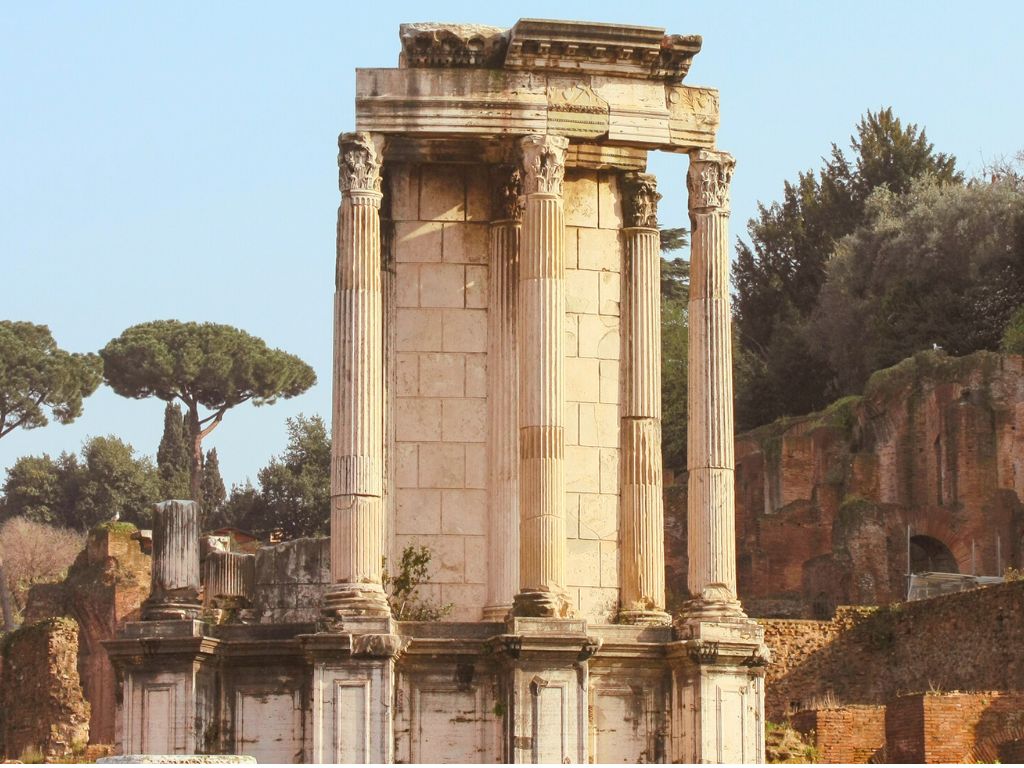
3. Temple of Vesta
The Temple of Vesta might be small compared to some of the other ruins in the Roman Forum, but it holds a big place in Rome’s history and mythology.
Dedicated to Vesta, the goddess of the hearth and home, this temple was where the sacred flame of Rome burned, symbolizing the city’s eternal life.
The temple’s circular shape makes it stand out; it’s not your typical rectangular Roman temple, and this unique design mirrors the shape of a hearth, which is pretty fitting for a goddess of fire.
Even though what’s left of the temple is just a few columns and the base, it’s easy to picture how grand it must have looked back in the day.
What’s even more fascinating is the story of the Vestal Virgins, the priestesses tasked with keeping the flame alive.
These women had one of the most important (and strict) jobs in ancient Rome.
They lived in the nearby House of the Vestal Virgins and had to follow some serious rules, like staying celibate for 30 years!
But they were also highly respected and enjoyed privileges that other women in Rome didn’t have.
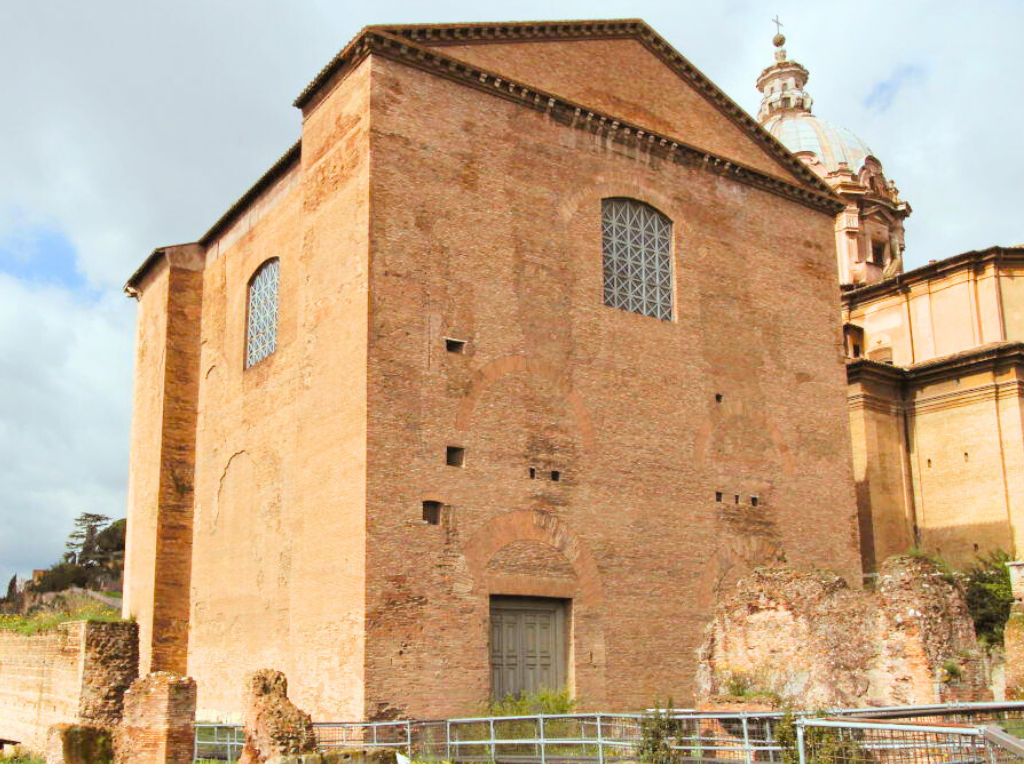
4. The Curia (Senate House)
The Curia, or Senate House, is one of the best-preserved buildings in the Roman Forum, and for good reason: it was the heart of political life in ancient Rome.
This is where senators gathered to debate laws, discuss state affairs, and decide the fate of the empire.
It’s a no-frills kind of building compared to the temples and arches nearby, but its simplicity speaks volumes about its importance.
The current structure dates back to 283 AD when Emperor Diocletian rebuilt it, and amazingly, much of it has survived intact.
Walking inside, you can’t help but feel the weight of all the decisions made within these walls.
What makes the Curia extra special is how well it gives you a sense of ancient Roman life.
Step inside, and you’ll see the original marble floors and high ceilings that once echoed with the voices of powerful men shaping history.
The tiered seating for senators reminds you that this was no ordinary meeting room; it was the beating heart of the Roman government.
Thanks to its later conversion into a church, the Curia avoided being scavenged for materials like many other ancient buildings.
Today, it’s one of the Forum’s hidden gems, offering you a window into the administrative side of the Roman Empire.
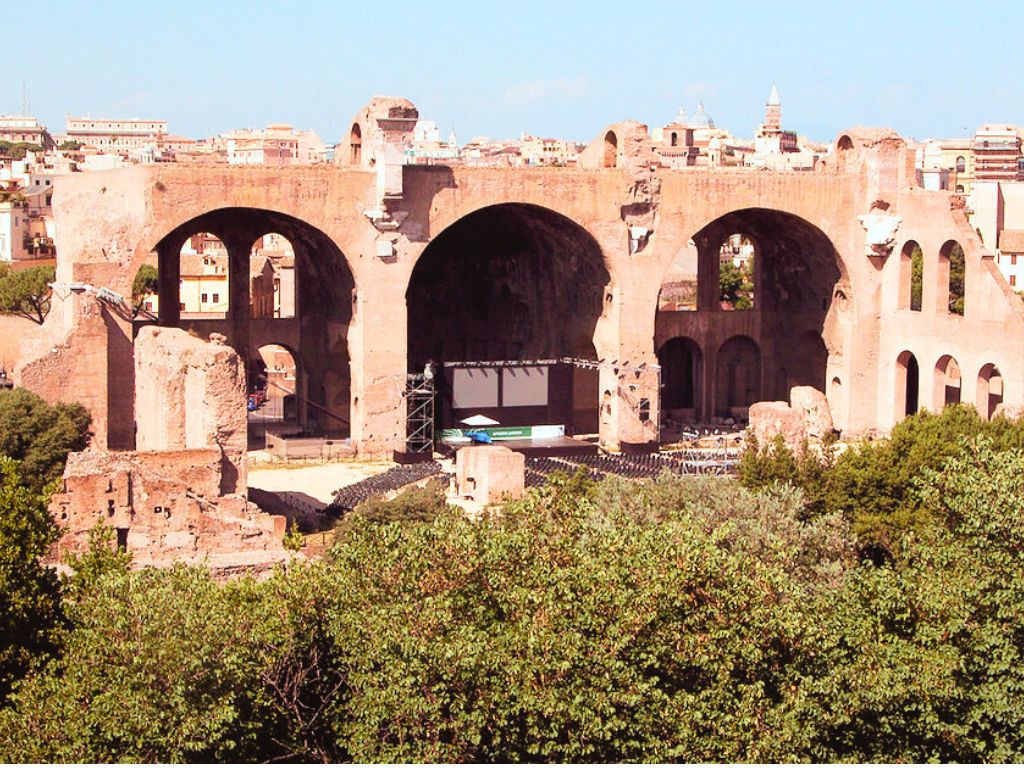
5. Basilica of Maxentius and Constantine
The Basilica of Maxentius and Constantine is a jaw-dropping reminder of just how advanced Roman engineering was.
Even though it’s mostly in ruins now, you can easily recognize its massive arches in the Roman Forum.
Built in the early 4th century AD, it was originally commissioned by Emperor Maxentius and later completed by Constantine after he defeated Maxentius in battle.
At the time, it was the largest building in the Forum and served as a public space for business, legal proceedings, and gatherings.
It was the ancient Roman version of a multipurpose hall!
What’s impressive is the architecture. The basilica featured an enormous vaulted ceiling supported by innovative designs that pushed the limits of Roman engineering.
Only one of the side aisles remains standing today, but it’s enough to imagine how grand the whole structure must have been.
Fun fact: this basilica is also where the famous colossal statue of Constantine was housed, parts of which are now displayed in the Capitoline Museums.
Also Read: How Many Forums Did Rome Have?
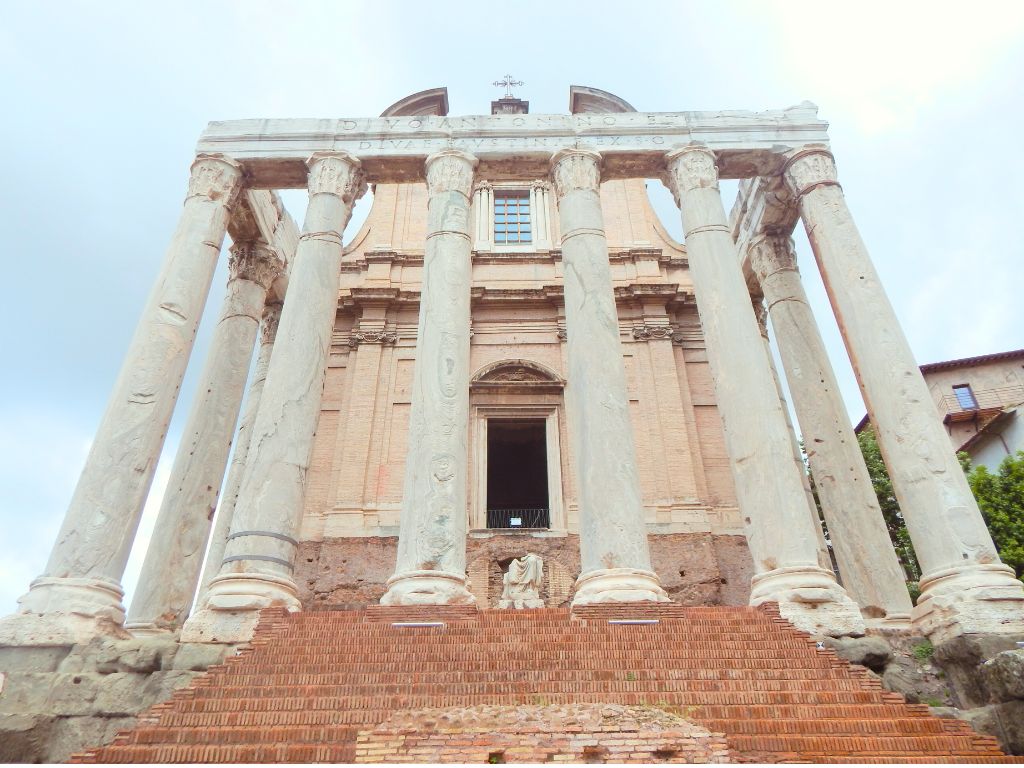
6. Temple of Antoninus and Faustina
The Temple of Antoninus and Faustina is one of the most striking ruins in the Roman Forum, blending the ancient Roman with a later Christian twist.
Built in 141 AD by Emperor Antoninus Pius, it was originally dedicated to his beloved wife, Faustina.
After Antoninus’s death, the temple was rededicated to both of them, making it a rare example of a structure honoring a couple.
Its impressive columns, carved from green Cipollino marble, still stand tall today, giving you an idea of how majestic it must have looked when it dominated the Forum.
In the 7th century, it was converted into the Church of San Lorenzo in Miranda, which is why it’s so well-preserved compared to many other ruins.
You can still see the fusion of the ancient and medieval worlds, with the original Roman columns framing the church’s later additions.
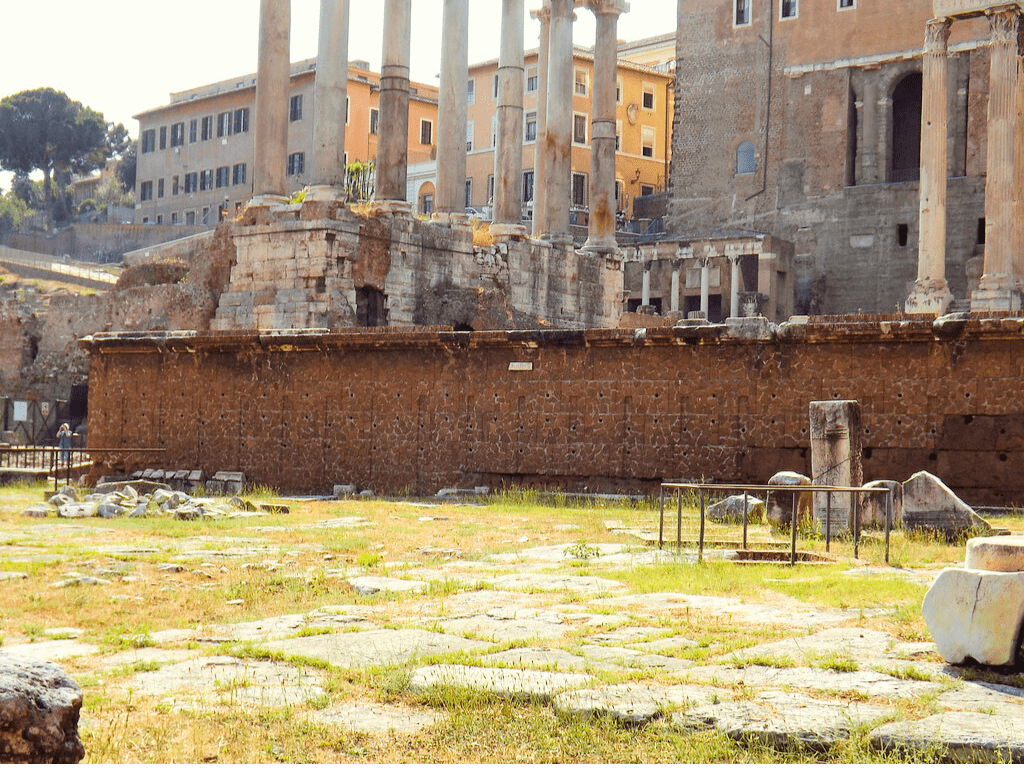
7. Rostra
The Rostra was the ultimate stage for public speaking in ancient Rome, where politicians, generals, and orators addressed the crowds gathered in the Forum.
This platform wasn’t just a random podium; it was a symbol of power and persuasion, the place where history was shaped through words.
The name “Rostra” comes from the bronze ship prows (rostra) that decorated it, trophies taken from enemy ships after a naval victory.
Standing here, it’s easy to imagine figures like Julius Caesar or Cicero delivering speeches that could define the fate of the empire.
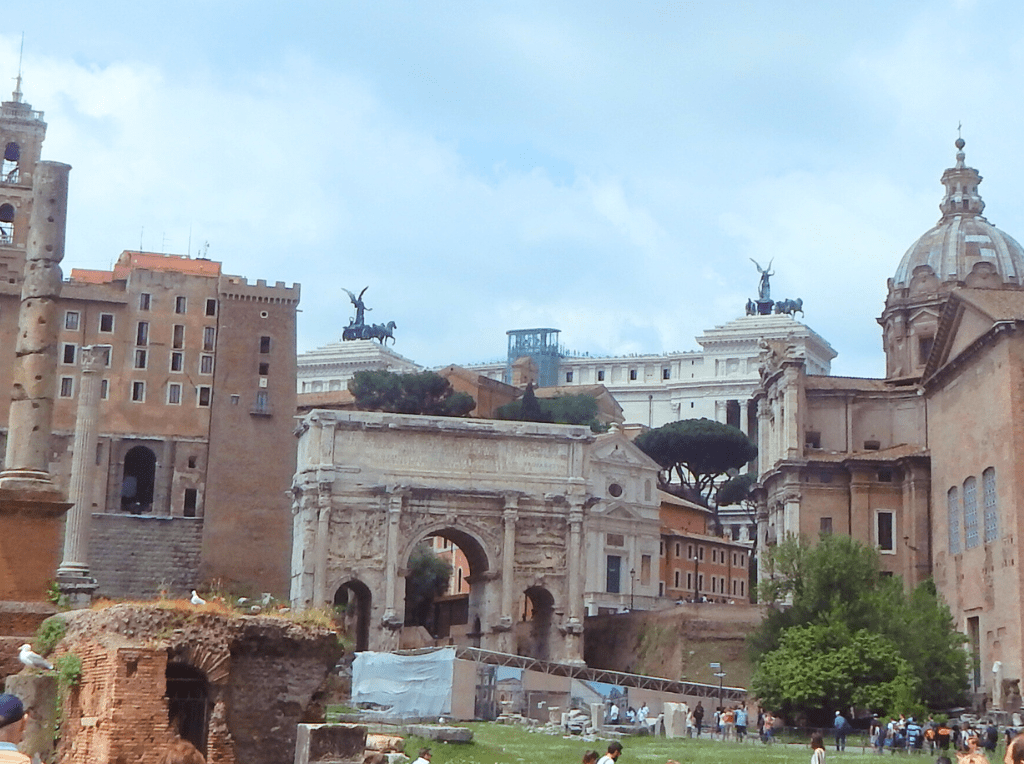
8. Arch of Septimius Severus
The Arch of Septimius Severus is one of the Roman Forum’s most eye-catching monuments, and it’s packed with history.
It was built in 203 AD, to celebrate Emperor Septimius Severus and his sons, Caracalla and Geta, for their military victories over the Parthians.
The detailed reliefs on the arch tell the story of these campaigns, with scenes of battles, prisoners, and victorious Roman soldiers.
One of the more dramatic stories tied to this arch is what happened after Septimius Severus’s death.
His sons, Caracalla and Geta, didn’t exactly get along, and after Caracalla had Geta assassinated, he ordered all mentions of his brother erased from the arch, a classic Roman move called damnatio memoriae.
If you look closely, you can still spot where Geta’s name was chiseled out.
Also Read: Guide to the Palatine Hill: 10 Monuments to See
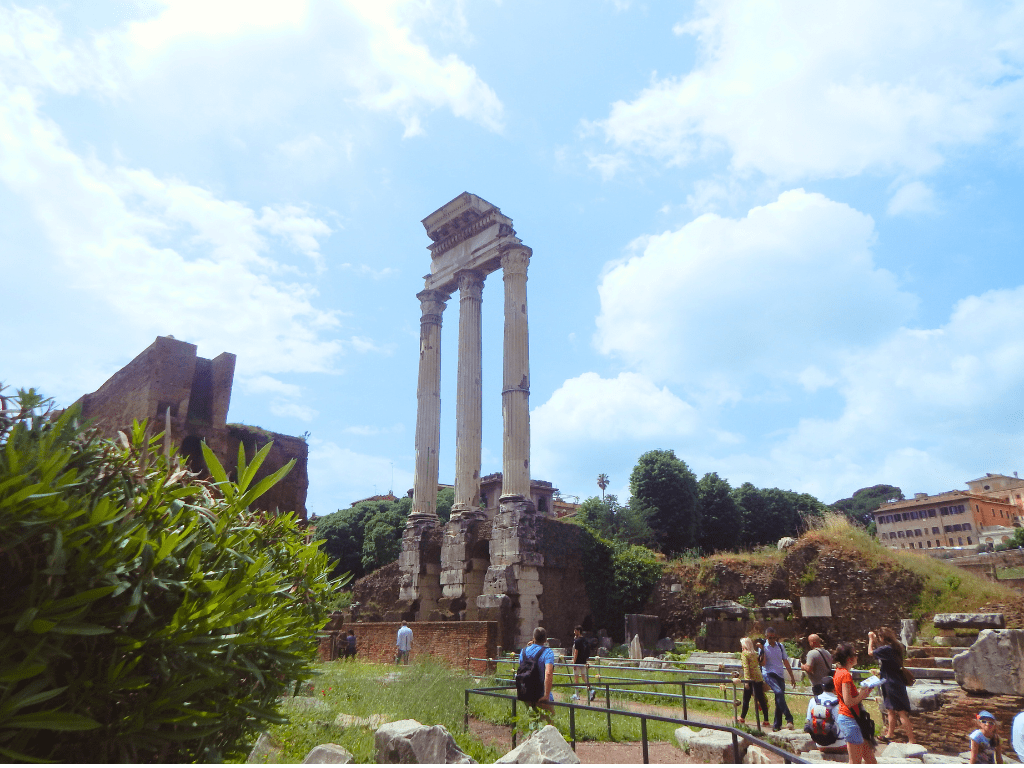
9. Temple of Castor and Pollux
The Temple of Castor and Pollux might not look like much today, just three Corinthian columns remain, but it was once one of the most impressive temples in the Roman Forum.
Dedicated to the twin gods Castor and Pollux, it commemorated their legendary role in a key Roman victory at the Battle of Lake Regillus in 495 BC.
According to myth, the twins appeared on horseback to help secure the win and then announced the victory in the Forum before vanishing.
The Romans honored them with this temple, which became a symbol of divine protection and military success.
What’s really cool about this temple is that it wasn’t just a religious site; it had a practical side too.
It was used as a meeting place for the Senate and even served as a depository for the state treasury at one point.
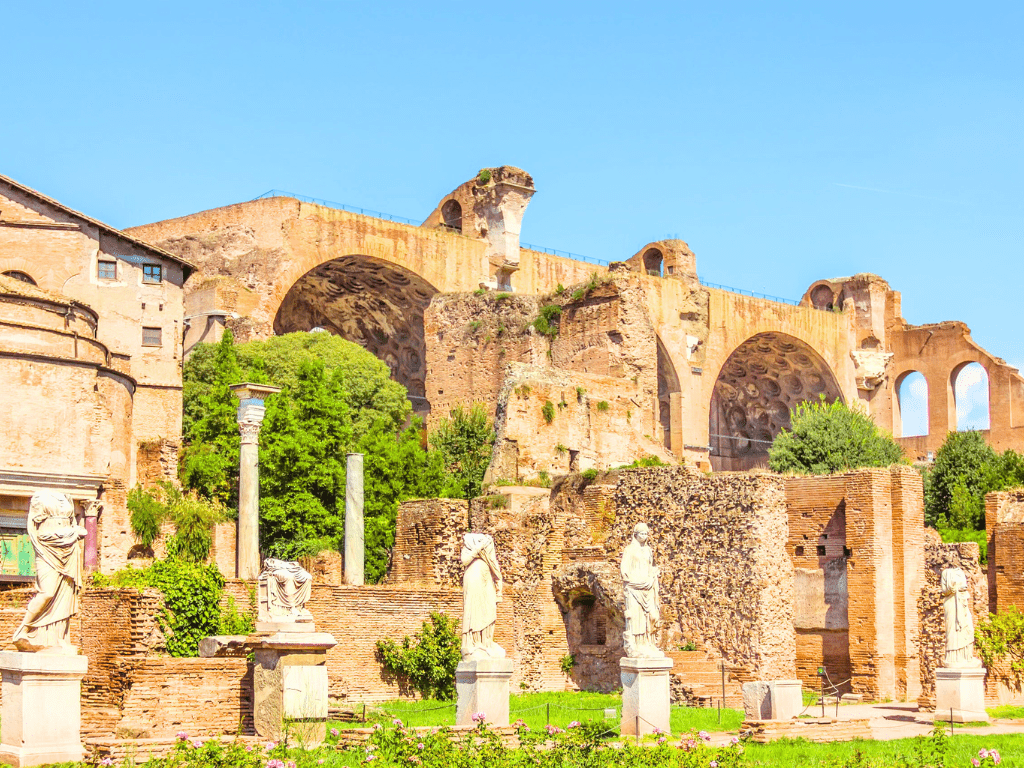
10. House of the Vestal Virgins
The House of the Vestal Virgins gives you a peek into the lives of some of ancient Rome’s most mysterious and revered women.
This was home to the Vestal Virgins, priestesses of the goddess Vesta, who were tasked with keeping the sacred flame of Rome burning, a symbol of the city’s eternal life.
The complex was surprisingly luxurious, with beautiful courtyards, gardens, and even fountains.
As you wander through the ruins, you can spot the statues of former Vestals, some with their names still engraved.
The Vestal Virgins were chosen as young girls and had to remain celibate for 30 years while serving Vesta.
If they broke their vows, the punishment was brutal: they would be buried alive!
But they were also highly respected, lived in this upscale residence, and had perks most Roman women could only dream of, like owning property.
11. Temple of Caesar (Temple of Divus Julius)
The Temple of Caesar, or the Temple of Divus Julius, is one of the most meaningful spots in the Roman Forum, marking the place where Julius Caesar was cremated after his assassination in 44 BC.
Built by his adopted son and heir, Emperor Augustus, the temple is a tribute to Caesar’s transformation from a powerful leader to a god in the eyes of the Romans.
While it’s mostly in ruins today, you can still see the altar where Caesar’s funeral pyre once burned.
Visitors often leave flowers or coins here, a touching nod to one of history’s most famous figures.
What’s really cool about this temple is that it symbolizes a major shift in Roman history: the end of the Republic and the rise of the Empire.
Augustus used it to cement his own power, linking himself to his deified father and showcasing his divine lineage.
The structure was once grand, with a high podium and a front-facing staircase.
Also Read: 20 Must-Visit Ancient Roman Ruins in Rome
12. Regia
The Regia might not look like much today, as just the foundation of stones still remains, but it was once one of the most important buildings in the Roman Forum.
This was the office and residence of Rome’s early kings and later served as the headquarters for the Pontifex Maximus, the high priest of Roman religion.
Think of it as a mix between a royal palace and a religious hub.
Its name, “Regia,” means “king’s house,” which gives you a hint at how deeply tied it was to the city’s earliest days.
Tradition says it was built by Numa Pompilius, Rome’s second king, who was known for his wisdom and religious reforms.
Even after Rome transitioned to a republic, the Regia remained a sacred space, housing important relics, like the ancilia (sacred shields) of Mars, the god of war.
Walking around its ruins today, it takes a bit of imagination to picture its significance, but knowing its role in shaping both Roman religion and governance makes it a must-see for history freaks exploring the Forum.
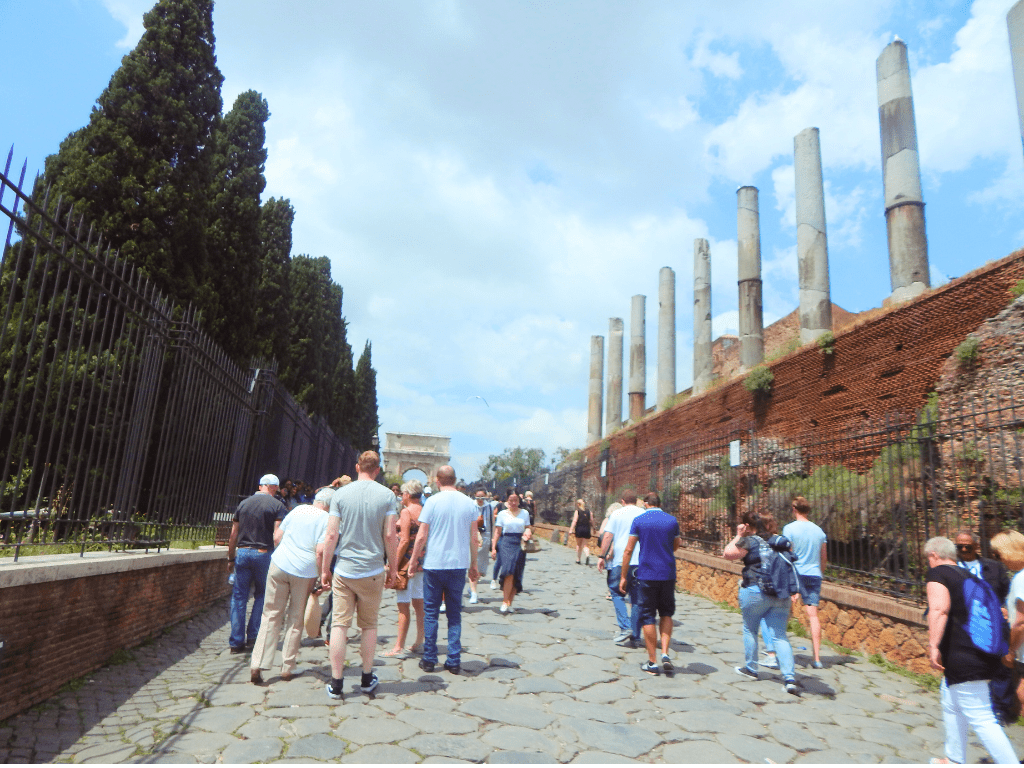
13. Via Sacra
The Via Sacra, or “Sacred Road,” is the main street that cuts through the Roman Forum, and it’s one of the oldest roads in the city.
This was the route for grand processions, like victory parades celebrating Roman military triumphs.
Picture legions of soldiers marching, trumpets blaring, and crowds cheering as victorious generals made their way to the Temple of Jupiter on the Capitoline Hill to offer thanks to the gods.
Walking along the Via Sacra today, you’re literally following in the footsteps of emperors, generals, and countless citizens who made history here.
What’s great about the Via Sacra is how it ties the Forum together.
As you stroll along its ancient stones, you’ll pass by some of the Forum’s most iconic landmarks, like the Arch of Titus, the Temple of Vesta, and the Basilica of Maxentius and Constantine.
It’s not hard to imagine the energy and life that once filled this road, with merchants, priests, and politicians all bustling around.
While much of the Forum is in ruins, the Via Sacra gives you a clear sense of how it is all connected.
For those interested in visiting more highlights of the Via Sacra, this guided tour takes you through the most important catacombs and must-see points alongside this famous road.
How to Visit the Roman Forum
Ticket
You can access the Roman Forum by buying the Colosseum, Roman Forum, and Palatine Hill priority ticket.
Basic Information
Opening hours
Open every day from 9:30 am until one hour before sunset.
Remember that the Roman Forum is closed on January 1st and December 25th.
How to get there
The easiest way to get to the Roman Forum is by metro, via line B, and get off at Coliseum station, which is right in front of the Colosseum and next to the Roman Forum.
Another option is by bus; the lines that pass near the Roman Forum are 60, 75, 84, 85, 87, 117, 175, 186, 271, 571, 810, and 850.
More About Rome
- Guide to the Palatine Hill: 10 Monuments to See
- 20 Must-Visit Ancient Roman Ruins in Rome
- How did the Roman Forum Look Like Before Excavations?
- How Many Forums Did Rome Have?
- Did Gladiators ever fight Lions?
- 3 Days in Rome Itinerary
- Christmas in Rome: Best Things to Do
- How to get to Rome Termini from Fiumicino Airport




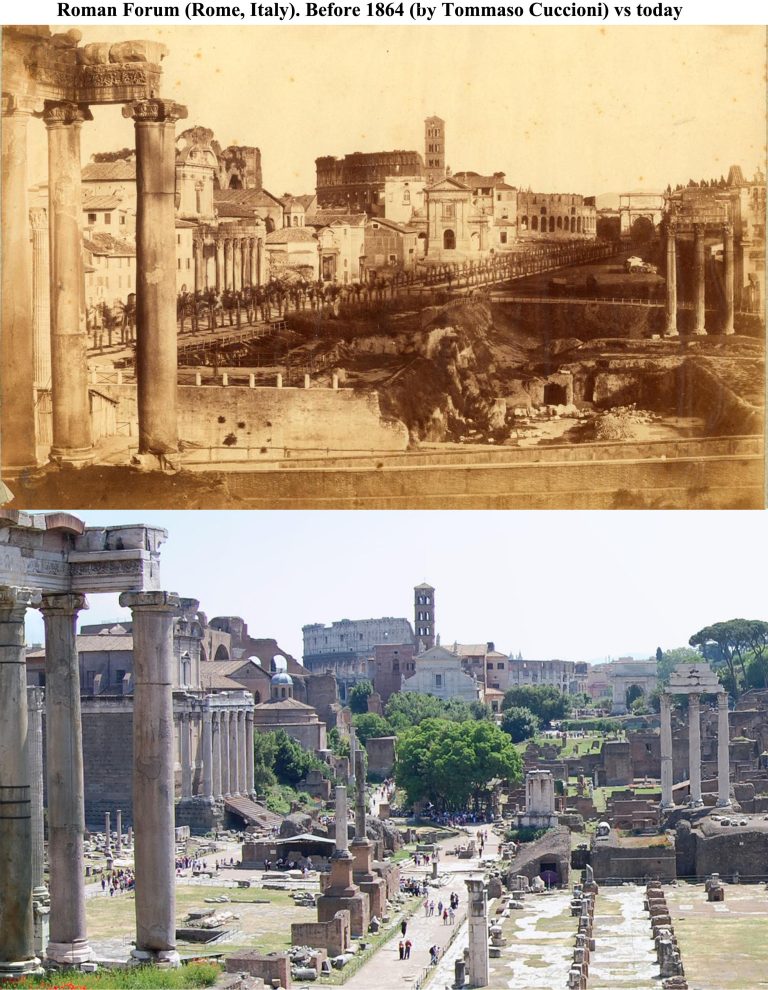
hi
Hello Tommy 🙂